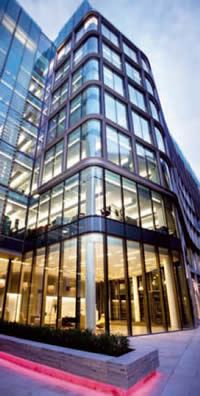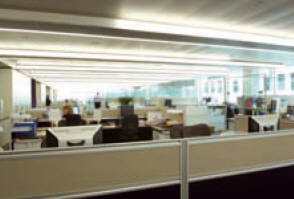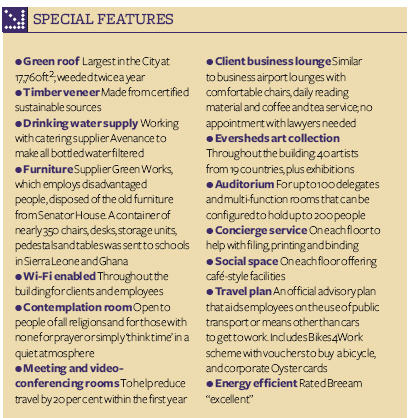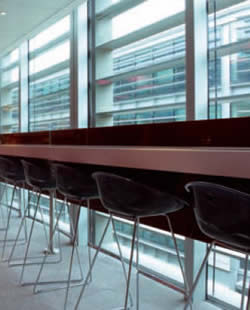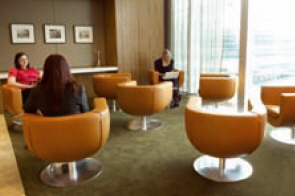by David Arminas — Sleeping on the job is frowned upon in the workplace. However, a tour of Eversheds’ new London headquarters reveals two unusual rooms. Each is similar to a comfortable but small hotel room with a single bed, a TV, clothes cupboard and wash basin.
These “rest pods” are for the legal firm’s lawyers who are under deadline and working across time zones. The pods are a place to lie down and “rest”. Sleeping in them is not officially allowed because Eversheds’ planning permission doesn’t allow “overnight accommodation”. The pods are part of Eversheds’ changed business culture aimed at creating a radically different environment where lawyers are free to work in the way that best suits them, either at the office, at home or remotely. The legal firm also wants its clients to feel free to work, meet and eat at Eversheds’ offices. At the same time they need a building that will cut their carbon footprint.
|
|
The firm had outgrown its previous accommodation, Senator House in the City of London, where it rented several floors. Eversheds was at maximum occupancy in the 1991 structure. Physical communication between lawyers was not easy. Client floors, where meetings took place with lawyers, were below ground level and had little flexibility for IT enhancements for presentation and remote working. Overall, the building was yesterday’s work environment at a time when the law firm wanted a place to enhance business strategy. That strategy, called “Make it Happen”, is about being flexible and having space to enable the business to work better — 24/7. A lot of Eversheds’ other UK offices — in Cardiff, Newcastle, Leeds and Birmingham — have, or are in the process of moving to, open plan.
The challenge in London was to complete a successful move into the seven-floor One Wood Street just off Cheapside in the City. The law firm now occupies an entire building and spent around £12 million to help the landlord, Land Securities, provide a flexible, egalitarian workplace with room for expansion. The essence of the building is a healthy work-life balance. This includes everything from the latest heating and lighting solutions (areas that generate employee complaints), to social spaces with cafe-style facilities, showers and the rest pods.
|
|
The migration in May went off with few hitches, says FM director John Flowers who came on board in November 2007. That was thanks to solid planning which started earlier that year before he arrived. But the physical migration was only half of Eversheds’ challenge. The other half was the migration of employees’ minds. That requires time, he says, and like the physical move, nothing is left to chance. “The challenge is to make the fit-out happen, but also to ensure that the culture changes.” When Flowers arrived, the template for the shift from Senator House to One Wood Street was already set.

Nonetheless, it was one of Flowers’ biggest challenges. “I walked into Eversheds as the project director, an overarching role and not just FM. I orchestrated various work streams for the entire project, working with project and cost manager, Capita Symonds and the fit-out contractor, ISG. There was file mapping, migration, risk and business continuity, IT, ‘speccing-out’ and signing contracts with new suppliers.”
|
|
He says he was well prepared having spent 20 years in the NHS, most recently as FM director for Mersey Care Trust, a specialist mental health and learning disability services for the people of Liverpool, Sefton and Kirkby. Flowers was based at Ashworth Hospital where he worked with the prison service to hand over a redundant trust building and 20 acres.
“We couldn’t have these 20 acres of site lying dormant. My job was to agree a lease with the prison service to convert it into a temporary 350-place custodial facility. I negotiated the lease and set it up for the service within eight months.” It was a politically sensitive deal given the government’s hammering by the media and opposition over overcrowded prisons.
Flowers admits to being fascinated by the processes and challenges of negotiation and communication. It is one aspect of what attracted him to the Eversheds job. A chartered mechanical engineer, he has a social sciences degree and an MBA from Sheffield Hallam University. He is currently working on his PhD on how public-private partnerships work. “In the engineering world everything is given, measured and accounted for. I went to the other extreme where outcomes are through conversations which are softer and less defined than the world of engineering. It’s about how people interface. No surprises but it’s down to the personalities and the culture of the organisation in which they work.” Joining Eversheds, Flowers had to get up to speed fast. “The early part of 2007 was for developing the brief. The fit-out had been running since September just before I joined. A mock-up area was set up in Senator House for employees to test drive their new accommodation. They wanted to know how tall it would be, how wide it would be. Touch it, kick it, smell it. This is not done much in Britain, but I saw it done in America.”
|
|
The move happened during the first two weekends in May, with more then 300 employees each time. But keeping the legal team operating without missing a single beat needed extensive file mapping. Lawyers were “gently persuaded” to review their files, to see if they really needed them operationally and if they could be sent to archives. This was strategic, says Flowers. “We simply did not have enough linear metres of shelving to accommodate the original amount. I worked with NewField IT, the lawyers and our departmental heads to engage them and get their confidence. They have enquiring minds and needed a rationale. You have to show you can help them do their work better. Otherwise it will be a struggle.”
That cooperation eventually reduced the filling volume by 57 per cent. Standard storage formats were developed and a clear-desk policy is now eliminating odd-sized boxes and loose files. Also, double-side printing has further reduced the amount of paper filed.
“We worked hard, briefing staff to manage their expectations and to caution some of these expectations, otherwise people’s goodwill evaporates with the heat,” says Flowers. “We knew that there would likely be problems with things like the air conditioning, going from too hot to too cold. We did wrestle somewhat with the chilled beam system which is in 90 per cent of the building.” Chilled beams are pipes running within the ceiling void whose cooled water chills the air around the pipes. The heavier, colder air sinks downwards, creating a natural airflow. This eliminates the need for coil fans which move the cooler air around the room. But the fans also create slight background noise that is sorely missed, says Flowers.
|
|
“If you are not careful you have a space that is uncannily quiet. What is needed is a little background noise, similar to that of the fans, to take away that stark silence where everything from conversations to phone calls are distracting. The answer was “pink noise”. Located throughout One Wood Street this system has tiny speakers concealed next to the chilled beams. Few are even aware of the piped-in hushing sound in the background. It sounds like coil fans. The open plan “legal studios” have glass partitioning to replace the old cellular offices. The studios are large and well-lit, with natural light from wall-to-wall windows. There is a university reading room feel to a studio that can accommodate a dozen or more lawyers who set up shop on the long desks for a day or so at a time. Docking stations for laptops are installed and there are keyboards and flat-screen VDUs available. Staff have adjusted to the change very well, says Flowers, but it is still early days. Organisations don’t change cultures by walking away from one building on a Friday and setting up in a new building on Monday. Senator House’s cellular office space is inherently territorial; One Wood Street is anything but. He acknowledges that there remains a need to “keep the momentum going” now that the physical migration has come and gone. There could be a battle against territoriality, acknowledges Flowers.
|
|
To this end a nine-member Future Working Life group has been set up that meets once a month. The group is chaired by a senior partner and includes heads of departments such as FM, HR, IT and business risk/continuity. Several other people or organisations are invited along depending on the issues to be discussed. Staff, too, are invited to discuss how they are getting along with the new environment.
The change, however, very nearly went terribly wrong for Eversheds. On the Friday after moving into the new international headquarters there was a bomb scare in the street and police stopped all parking. “Had that been the previous Friday, it would have been disastrous for the migration and had an impact on our ability to conduct business as usual on Monday.”
David Arminas is a freelance journalist
